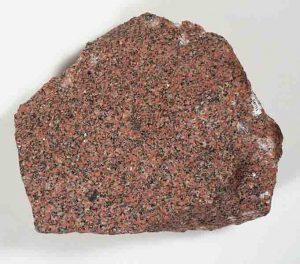
Polymineralic rocks are rocks formed by more than one type of rock forming minerals.
The rheology of polymineralic rocks is complex as the various minerals within the rock have different deformational behaviors (e.g. deformation mechanisms, activation energies). This results in unequal distribution of stress and strain throughout the rock (Jordan, 1988; Passchier & Trouw, 2005).
The stress network of a polymineralic rock depends on the type of minerals found within the rock (hard and soft minerals), and the ratio in which they exist. Experimental deformations of two solid-phase rocks indicated that the soft minerals have a disproportionally large effect on the strength of the rock (Le Hazif, 1978). External conditions also have a big impact on the interaction of these hard and soft minerals (Passchier & Trouw, 2005).
Polymineralic rocks display three end‐member types of mechanical and microstructural behavior:
- Strong minerals form a load‐bearing framework that contains spaces filled with weaker minerals;
- Two or more minerals with low relative strengths control bulk rheology and form elongate boudins;
- One very weak mineral governs bulk rheology, while the stronger minerals form clasts.
An example of a polymineralic rock
Granite, which is mainly composed of quartz along with plagioclase feldspar.
Reference:
- Gower, R. J., & Simpson, C. (1992). Phase boundary mobility in naturally deformed, high-grade quartzofeldspathic rocks: evidence for diffusional creep. Journal of Structural Geology, 14(3), 301-313.
- Handy, M. R. (1990). The solid‐state flow of polymineralic rocks. Journal of Geophysical Research: Solid Earth (1978–2012), 95(B6), 8647-8661.
- Hippertt, J., Rocha, A., Lana, C., Egydio-Silva, M., & Takeshita, T. (2001). Quartz plastic segregation and ribbon development in high-grade striped gneisses. Journal of Structural Geology, 23(1), 67-80.
- The solid‐state flow of polymineralic rocks










